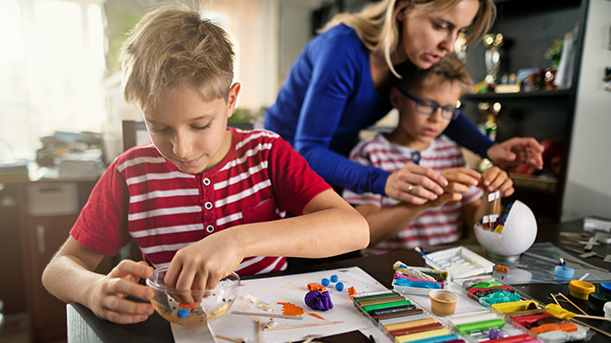BOOMbox at Home: Fabrication Activities
May 6, 2020

This week we’re exploring fabrication or, in other words, making things.
Rapid Prototyping
Rapid prototyping is making a product in a quick way with cheaper resources and often at a smaller scale or size than the final product. Having a prototype allows engineers to improve designs and functionality of an object, ranging from a yogurt container to a computer. Cardboard is a great material to use in rapid prototyping, and we have two rapid prototyping challenges for you to try.
First up, cardboard automata! Automata are moving sculptures, complete with levers and links that make up simple mechanics. The Exploratorium, a science museum in San Francisco, CA, provides a helpful cardboard automata activity guide as part of their Tinkering Studio. Grab some cardboard, tape, glue, and any other crafting supplies you have around to get started on your moving sculpture.
Another project you can try is rapid prototyping cardboard vehicles. Can you make a car? Or a rocket? Which features make your car or rocket unique? How can you optimize or improve your designs?
Spaghetti Tower Marshmallow Design Challenge
This classic design challenge has been used as a team building and creative thinking exercise for participants of all ages. The spaghetti tower marshmallow challenge has strict parameters and limited resources, like how many spaghetti sticks you can use and how much time you have to construct your tower. Tinkerlab.com has an overview of the challenge and includes ways to engage in teams. To construct your tower, you’ll need:
- 20 sticks of dry spaghetti
- 1 yard of string
- 1 yard of tape
- 1 large marshmallow
- Scissors
- A timer--on your microwave, phone, or a stopwatch
You can repeat this challenge over and over, which is par for the course of rapid prototyping. After you build, reflect on the experience:
- Which structures best support the weight of the marshmallow?
- What was the most frustrating part of the design challenge and why?
- What surprised you in your building?
How It’s Made
Curious about how different things in your daily life are made? Discovery UK's "How It's Made" series invites viewers to learn about the production of everything from drones to donuts. Some of their videos are available on YouTube.
Here are two playlists to get you started: How It’s Made and How It’s Made Part 2. What will you be inspired to make after watching?
Finger Knitting
Finger knitting is a great entrance into the world of textile fabrication, or yarn crafts. It’s easy to learn, helps you learn the techniques behind knitting and crochet, and once you get the hang of it you can do it while watching TV or listening to music.
You’ll need some chunky yarn for best results, but any yarn you have at home will do. If you don’t have any yarn available, you can upcycle an old t-shirt to make some. Instructables has posted directions on how to make t-shirt yarn. You’ll also need scissors and a clean workspace.
If you learn best by reading and following photos, Happy Homeschool Nest provides a great finger knitting tutorial for beginners.
If you prefer learning by watching, here are two great introduction videos to get your started: How to do Finger Knitting from Red Ted Art and How to Finger Crochet a Scarf from Michaels.
Ready to take your finger knitting to the next level? Go to Creativebug, which you can access using a Skokie library card. Make an account, then search for "finger knitting."
Journey Stick
Try a fun fabrication activity that uses items found in your environment--a journey stick. A journey stick is like a nature stick, made of things you find on outdoor walks to remind you of your journey. The Growing Family blog has an overview of how to make your own journey stick. Make sure to use pieces of nature that are readily available, like fallen leaves, bark, rocks, or sticks, being mindful of your environment. Your journey could be a walk around the neighborhood or even in your backyard.
Share
We’d love to see the results of your experiments! Tag @skokielibrary when you share photos of what you’ve created on social media.
This week's post was written with Eli, Erica, and Frannie.